Commercial buildings need to be comfortable and functional, which requires an effective HVAC system. The United States Department of Energy estimates that nearly half of a commercial building’s energy consumption comes from heating, cooling and ventilation, highlighting the importance of efficient design and implementation. By considering these aspects of a commercial HVAC system, technicians can Read more
Whats New
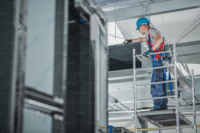
Commercial buildings need to be comfortable and functional, which requires an effective HVAC system. The United States Department of Energy estimates that nearly half of a commercial building’s energy consumption comes from heating, cooling and ventilation, highlighting the importance of efficient design and implementation. By considering these aspects of a commercial HVAC system, technicians can identify ways to help property owners increase energy savings.
System Design
Peak efficiency presumes that the system itself has an efficient design. Many commercial buildings, especially those built decades ago, do not feature efficiency in the structure design or use. As a result, poorly designed systems may hinder efficiency efforts, when HVAC technicians can only upgrade the equipment. Instead, evaluating the design can yield new opportunities for increasing efficiency, such as changing the placement of windows or increasing insulation to minimize heat transfer. Even reconsidering the type of HVAC system — by switching from a split system or packaged system to an efficient alternative like geothermal — could significantly decrease operating expenses and energy use.
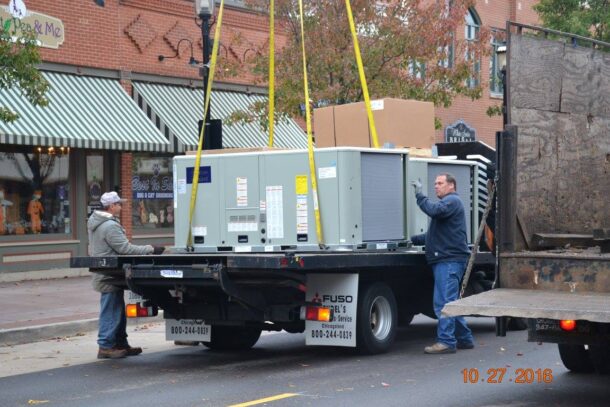
Component Upgrades
When planning upgrades for the commercial space, efficiency should be a key component of the decision. Maximum efficiency for the equipment is a lofty goal and may be necessary depending on the comfort needs of the space or the sustainability goals of the property owner. Upgrading a system can happen in pieces, but technicians should weigh the advantages of a full replacement against the lower cost of upgrading equipment over time. In some cases, the equipment will not provide the same level of efficiency if it must interact with older, inefficient units or devices. Upgrades that affect sizing or output may require other system updates, such as ductwork repair, to maximize efficiency.
Proper Sizing and Installation
The ideal equipment depends on the commercial building’s size, layout and other factors. Correct sizing and professional installation are key to maintaining peak output and efficiency over time. Units that are too small for the load may take on too much stress, leading to repairs and premature replacement. Systems that are too large may provide cooling too quickly to ensure ideal humidity control. HVAC technicians should perform a load calculation before recommending specific units and schedule professional installation as part of the upgrade. Accurate installation can preserve efficiency and output through the equipment’s lifespan.
Smart Controls
Better energy consumption comes from the equipment itself, its installation and the use of the system. Many commercial property owners lose out on energy savings because they lack the tools to minimize their energy consumption, or they worry that cutting back on usage will compromise comfort. Technicians can assist by explaining how efficient controls can work with the system to improve efficiency and decrease waste. Implementing smart controls with effective settings can help property owners to reach their targets for comfort and energy efficiency.
Regular Maintenance
Even the best design and equipment installation requires routine care to keep it in ideal working order. Property owners should arrange for annual heating and cooling services — in the fall for heating and the spring for cooling. Regular maintenance can provide the following:
- Professional test of the system
- Inspection of components and systems
- Cleaning and lubrication of moving parts
HVAC systems often lose efficiency over time, due to gradual wear and tear on the equipment. Routine upkeep can minimize efficiency losses by ensuring proper operation of the equipment each year, with early notice of problems to fix.
Improving HVAC efficiency for commercial buildings offers many benefits. It can lower operating costs, minimize breakdowns, remove stress from the local power grid and improve the environment. By implementing this advice, HVAC technicians can assist their commercial clients in maximizing efficiency.
Guest Blogger: Steve Kops is Owner and Expert Service Technician of Kop’s Repair. He is a dedicated professional with extensive experience in the HVAC, plumbing and electrical industries. As a key member of Kop’s Repair, he brings over 40 years of expertise and is known for his commitment to providing top-notch, reliable service and maintaining high standards of customer satisfaction.
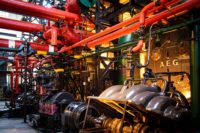
Large facilities contain several systems that require regular maintenance and attention to continue to work properly. Despite routine upkeep, sometimes these systems will fail on occasion. When a failure happens, building managers must request services from an appropriate professional to identify the cause and address the problem. With these troubleshooting tips, professionals can determine the Read more
Large facilities contain several systems that require regular maintenance and attention to continue to work properly. Despite routine upkeep, sometimes these systems will fail on occasion. When a failure happens, building managers must request services from an appropriate professional to identify the cause and address the problem. With these troubleshooting tips, professionals can determine the extent of the issue and arrange for effective repairs.
Fire Safety Concerns
Fire safety is a key component of large facilities, as it can affect people, structures and systems. Although most buildings are required to have comprehensive fire safety systems in place as a regulatory concern, these systems often do not receive routine testing. Building managers should:
- Conduct fire safety drills regularly and test each component of the system for function
- Look for clogs in the water lines or mineral deposits around the sprinkler heads
- Test smoke extractors for proper suction
- Check fire extinguishers for use dates and replace when necessary
Plumbing Failures
In larger buildings, a plumbing failure can quickly create a disaster. Plumbing problems usually come in the form of leaks and blockages — either can lead to significant water damage within a short period of time. To troubleshoot these issues, plumbers should look for explanations for low water pressure and identify signs of water damage on floors, walls or outside the building. If the source is not immediately apparent, a sewer line camera can allow a plumber to see through the lines with the highest likelihood of a problem. Once the leak or blockage is found, a plumbing professional can fix the leak or clear the blockage.
HVAC Malfunction
HVAC system malfunction is more than an issue of comfort. Lack of ventilation in industrial settings can allow harmful chemicals to accumulate, putting people in the building at risk. HVAC systems need professional maintenance at least once a year to maintain proper function and efficiency. Common HVAC problems include:
- Poor airflow
- Ventilation failures
- Ineffective heating or cooling
- Excessive energy usage
Testing the function of each system can yield several possible causes, such as a faulty motor, dirty coils or a cracked burner. By systematically going through the system, an HVAC technician can determine the cause and provide expert heating system repair.
Elevator Breakdowns
Elevator failure can be a minor inconvenience or a serious problem depending on the cause and extent of the failure. Elevators rely on a system of cables and pulleys, all set to electrical equipment that causes the elevator to raise or lower. A failure at any point in the system can cause elevator speed to change, doors to refuse to open, or the entire system to shut down. Elevators need routine maintenance to confirm correct operation, including load testing. Professionals should test operation of the elevator while it is unoccupied, especially if certain aspects are faulty.
Electrical Outages
Electrical outages can create significant risks for the occupants of the building, depending on the cause. To test the system, professionals should clear the building and evaluate for signs of a loose or damaged wire. If everything seems to be in order, testing the circuits at the panel can help to identify where the outage has happened. A tripped breaker may be relatively simple to fix, while a full outage could be caused by a failure of the municipal power grid. Systematic testing can determine whether the outage comes from a single portion of the electrical system or another cause.
Keeping all the systems running in a large facility calls for regular testing, inspection and repairs from professionals when needed. Building managers should maintain a list of systems and ensure that each one receives yearly maintenance for ideal output and operation. By troubleshooting problems as they arise, professionals can find the cause and minimize damage to the structure or other systems in the building.

Despite what many people think, artificial intelligence isn’t just for giant tech companies or futuristic labs anymore. It’s becoming an everyday tool for businesses of all shapes and sizes. Even the average store on the corner or a small family-run cafe can use AI to grow, connect with customers, and make their work smoother. In Read more
Despite what many people think, artificial intelligence isn’t just for giant tech companies or futuristic labs anymore. It’s becoming an everyday tool for businesses of all shapes and sizes. Even the average store on the corner or a small family-run cafe can use AI to grow, connect with customers, and make their work smoother.
In fact, using AI doesn’t have to be complicated or expensive. It’s about finding the right tools to make life easier and business better.

Making work faster and easier
Running a business often means juggling countless tasks such as answering emails, managing inventory, scheduling staff, and more. AI can take some of that load off your shoulders. For instance, chatbots powered by AI can handle customer inquiries 24/7, giving people quick answers while saving you time. These bots are perfect for handling common questions like store hours or refund policies.
AI tools can also help with scheduling and inventory management. For example, software that predicts trends can suggest how much stock to order based on past sales, preventing over-ordering or running out of popular items. These tools can save time and money while keeping shelves stocked with what customers want.
Building stronger customer connections
Customers love businesses that understand their needs and provide a personal touch. AI can help by analyzing customer behavior to suggest what they might like. Think of a local clothing store that uses AI to recommend outfits based on what shoppers have previously bought. This isn’t just about big brands; even small businesses can tap into tools that do the same thing.
Another way to connect with customers is through social media. AI can analyze what posts or promotions are working best, helping businesses focus on what people enjoy.
Smarter marketing with AI
Marketers are using AI to create campaigns that speak directly to customers. For an average business, this might mean automating email campaigns or using AI to decide the best time to post on social media. For example, an AI tool could help a small bakery send special offers to customers who haven’t visited in a while.
AI also makes it easier to keep track of how campaigns are performing. Instead of guessing what works, AI analyzes results and provides insights into what could be improved. When combined with good marketing practices, these tools help businesses stay relevant and engaging without needing a huge budget or a team of experts.
Keeping up with competition
It might feel like AI is only for big businesses with deep pockets, but that’s not true. Many AI tools are affordable and simple to use, even for those who aren’t tech-savvy. By adopting AI, small businesses can stay competitive with larger ones. For instance, a local bookstore could use AI to recommend new arrivals to its loyal readers, just like big online retailers do.
Staying competitive doesn’t mean trying to do everything at once. Start small, focusing on areas where AI can make the biggest difference. Over time, these small changes can help a business stand out in a crowded market.
Saving money with AI
One of the biggest misconceptions about AI is that it’s expensive. In reality, many tools are affordable or even free. Using AI can actually save money in the long run by cutting down on wasted time, reducing mistakes, and streamlining operations.
For example, AI-powered accounting software can quickly sort through receipts and invoices, reducing errors and saving hours of manual work.
Learning what works and what doesn’t
AI is a powerful tool for figuring out what’s helping your business grow and what might be holding it back. For instance, AI can track which products are selling well and which ones are collecting dust. This data can guide smarter decisions, like deciding which items to promote or discontinue.
Even on social media, AI can analyze trends to show what types of posts are getting the most likes or shares.
Growing without overcomplicating
AI isn’t about reinventing the wheel or making life more complicated. It’s about making things simpler, faster, and better. By embracing AI tools, the average business can grow without sacrificing the personal touch that customers love. From streamlining operations to connecting with people in meaningful ways, AI opens up opportunities that were once out of reach.
AI doesn’t need to be intimidating or expensive. It’s a tool that even the most humble business can use to improve how they work, serve their community, and grow. Whether it’s answering questions faster, creating smarter campaigns, or learning what works, AI can help businesses stay competitive and thrive.
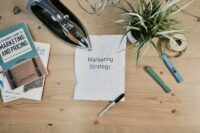
Marketing your services effectively requires understanding that different age groups respond to messages, platforms, and strategies in unique ways. Each generation has its own preferences, habits, and values, which means businesses need to tailor their marketing efforts accordingly. So from targeting tech-savvy millennials to reaching loyal baby boomers, we’ll cover how to successfully market your Read more
Marketing your services effectively requires understanding that different age groups respond to messages, platforms, and strategies in unique ways. Each generation has its own preferences, habits, and values, which means businesses need to tailor their marketing efforts accordingly.
So from targeting tech-savvy millennials to reaching loyal baby boomers, we’ll cover how to successfully market your services to different age groups and ensure your efforts resonate with a diverse audience.

Understanding your target audience
Before creating a marketing strategy, it’s important to identify your franchise’s target audience. Different age groups have unique expectations, so knowing who you want to reach helps refine your messaging and delivery. For instance, a franchise selling health-conscious snacks may focus on younger audiences, while a luxury home improvement business might aim for older homeowners.
Understanding your audience involves analyzing their habits, values, and preferred communication channels. While Gen Z might spend more time on TikTok, baby boomers are more likely to engage with email campaigns or traditional advertisements. Taking the time to research each group’s behavior helps build an effective marketing plan that connects with your audience.
Marketing to Gen Z
Gen Z has grown up in the digital age, making technology and social media central to their lives. This generation values authenticity, inclusivity, and brands that reflect their values. To reach them, franchises should focus on platforms like Instagram, TikTok, and YouTube, where visually appealing and shareable content thrives.
Gen Z prefers short, engaging videos or posts that provide value, whether through entertainment or information. For example, a fitness franchise could share workout tips on Instagram Reels or collaborate with influencers to promote services. Engaging with this group requires staying current with trends and creating relatable content that feels genuine rather than overly polished.
Connecting with millennials
Millennials are a generation known for valuing experiences, convenience, and sustainability. Marketing here often means highlighting a franchise’s commitment to social causes, eco-friendly practices, or innovative solutions. For instance, a waste management industry network could appeal to millennials by emphasizing responsible recycling initiatives or sustainable waste disposal methods.
Social media, email marketing, and apps are effective tools for engaging millennials, who often research brands online before making decisions. Businesses can build trust by being transparent and responsive. For example, a restaurant franchise could use Instagram to showcase locally sourced ingredients or a loyalty app to reward frequent customers, creating a connection that goes beyond the product.
Reaching Gen X
Gen X is often described as a bridge between older and younger generations. This group values practicality, reliability, and brands that save them time. For franchises, it’s important to focus on quality and convenience when marketing to Gen X.
Email campaigns, Facebook ads, and loyalty programs are effective ways to reach this generation. For example, a cleaning franchise might emphasize its ability to handle household tasks efficiently, freeing up time for busy families. Gen X appreciates clear communication and reliable service, so testimonials and reviews can also be powerful tools for building trust.
Engaging baby boomers
Baby boomers are often loyal customers who value traditional marketing methods. While this group is increasingly tech-savvy, they still respond well to direct mail, television ads, and print materials. For franchises, it’s essential to offer clear, straightforward messaging that highlights the benefits of your product or service.
Boomers also value personal interactions, so excellent customer service is crucial. For example, a travel franchise might engage this audience by offering personalized vacation packages and highlighting senior-friendly amenities. Building loyalty with baby boomers often means focusing on trust, reliability, and strong customer relationships.
Tailoring your message for each age group
The tone, style, and content of your messaging should reflect the preferences of the audience you are targeting. For younger generations like Gen Z and millennials, a conversational tone and vibrant visuals are key to grabbing attention. For example, an upbeat social media campaign with humor or trending challenges might appeal to these groups.
Older generations, such as Gen X and baby boomers, often prefer a more professional tone and detailed information about products or services. A home maintenance franchise targeting Gen X, for instance, could focus on the long-term value and practicality of its services in emails or brochures. Adapting your tone and style shows that your franchise understands its audience’s needs.
Choosing the right platforms
Different age groups have different preferences when it comes to communication platforms. Gen Z spends significant time on TikTok, Snapchat, and Instagram, so focusing on these channels with creative and engaging content is a smart choice. Millennials also use Instagram but are more likely to engage with brands on Facebook or through apps.
For Gen X and baby boomers, Facebook remains a powerful platform, while email marketing and traditional ads hold strong appeal. A healthcare franchise, for example, could run targeted Facebook ads for Gen X while mailing informational brochures to baby boomers. By choosing the right platforms, your franchise can reach its audience where they are most active and receptive.
Leveraging the power of influencers
Influencers can play a significant role in reaching younger audiences, particularly Gen Z and millennials. Partnering with influencers who align with your franchise’s values allows you to tap into their loyal following and gain credibility. For example, a wellness franchise could collaborate with fitness influencers to showcase their services through Instagram Stories or YouTube videos.
While influencers are often associated with younger generations, micro-influencers can also be effective for reaching niche audiences, including older groups. A gardening franchise, for instance, might partner with a gardening enthusiast who shares tips and reviews with their followers. Influencer partnerships can help build trust and increase awareness for your franchise across age groups.
Measuring and adapting your strategies
Marketing to different age groups requires ongoing effort and flexibility. Tracking the performance of your campaigns helps identify what works and what doesn’t, allowing you to adjust your strategies accordingly. For example, analyzing social media engagement can reveal which platforms and types of content resonate most with younger audiences.
Older generations might respond more to direct mail or email, so monitoring open rates and response rates can provide valuable insights. Whether it’s tweaking your messaging, trying a new platform, or shifting your focus, adapting to your audience’s preferences ensures your marketing efforts remain effective and relevant.
Summary of how to target different age groups
Gen Z
- Gen Z thrives on platforms like TikTok, Instagram, and YouTube, where visually engaging and authentic content captures their attention.
- This group values inclusivity and environmental responsibility, so campaigns should reflect these priorities.
- Short, entertaining videos or collaborations with influencers are effective ways to connect with this tech-savvy and trend-focused audience.
Millennials
- Marketing to millennials means prioritizing experiences, convenience, and sustainability, making it essential to highlight eco-friendly practices and brand transparency.
- Engaging on Instagram, Facebook, and through loyalty apps fosters meaningful connections.
- Sharing your brand’s journey through storytelling or showcasing commitments to social causes can create emotional bonds with this socially conscious and digitally connected generation.
Gen X
- Gen X values practicality and convenience, responding well to marketing that emphasizes time-saving solutions and reliable products.
- Email campaigns and Facebook remain effective platforms to reach this audience.
- Highlighting customer reviews and testimonials builds trust, while clear, informative messaging about product benefits appeals to their preference for straightforward communication.
Baby boomers
- Baby boomers are loyal and appreciate personal interactions, making traditional methods like direct mail, print ads, and exceptional customer service vital.
- They respond to messages that highlight value, reliability, and quality.
- Personalized experiences, such as tailored vacation packages or thoughtful customer service, strengthen connections with this audience that values trust and relationships.
Marketing your services to different age groups involves understanding their unique preferences, habits, and values. By adapting and staying connected, your services can appeal to a diverse audience and build lasting relationships across age groups.

As the new year rings in, it’s often worth reflecting on our operational practices straight from the fundamentals. Doing so can ensure we move forward with confidence and clarity, and better prepare against any mistakes, or make good on any lessons we learned from 2024. This is at the heart of any construction effort, as Read more
As the new year rings in, it’s often worth reflecting on our operational practices straight from the fundamentals. Doing so can ensure we move forward with confidence and clarity, and better prepare against any mistakes, or make good on any lessons we learned from 2024. This is at the heart of any construction effort, as no building will stand for long without strong principles and foundations ensuring quality.
It’s extremely common for businesses to collaborate on construction projects, from contractors working nearby to architects collaborating with construction outfits. Often, most owners will want to know if the opposing businesses are correctly briefed if they can be trusted to do a good job, and if they won’t get in the way of (or override) any essential work they hope to achieve.
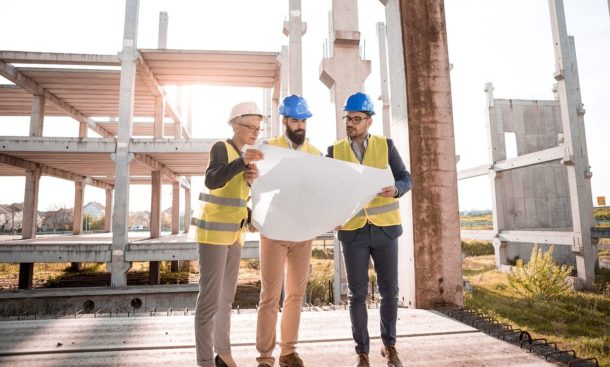
But perhaps this year you wish to take more of a steadfast approach towards who you collaborate with in the area. Let’s discuss what these principles might involve:
Design-Assist Building
Working together from day one is not always available, but perhaps you wish to adhere to this functional standard as SCB Construction Group does. That’s because it’s clear that when architects and builders plan together, they catch problems early and solve them before they become expensive fixes. This old-school method has found new life lately because it just works more cleanly and especially for advanced projects. Even when collaborating with other brands, your team learns to trust each other’s judgment, share ideas openly, and build exactly what the client needs. This means that the documented plans become the obvious reference point, but you can also read the potential of all outcomes backwards and forwards through the process.
Eco-Sustainability
2025 is the year of green building as more and more clients are going to keep this priority front and centre. This might mean switching up your providers, as modern materials and methods that buildings use less energy, commit less emissions and last longer will be essential. Solar panels, better insulation, and smart design choices pay for themselves through lower running costs, and training staff on their installation and maintenance will also be essential. Clients appreciate this thoughtful approach, especially when you can show them exactly how these choices benefit their project as part of your pitch. The best part is that sustainable buildings often feel better to work in, with more natural light and fresher air, so that’s a bonus too.
Materials Sourcing and Hiring
Many companies have placed a repeated emphasis on local procurement, and depending on your realistic project goals, that might work for you. This means local partners often become your best allies, because they know the area, understand local building codes as closely as you do, and care about their reputation in the community. Finding good suppliers takes time, but reliable partners make every project easier. Hiring locally also grants you the same character, as good workers who know what they’re doing are worth their weight in gold. If you continue to train them well, treat them fairly, and they’ll stick around, especially if you aim to roll out more apprenticeship programs to give people their start.
With this advice, you’ll be more than able to help collaborative construction projects going forward.
